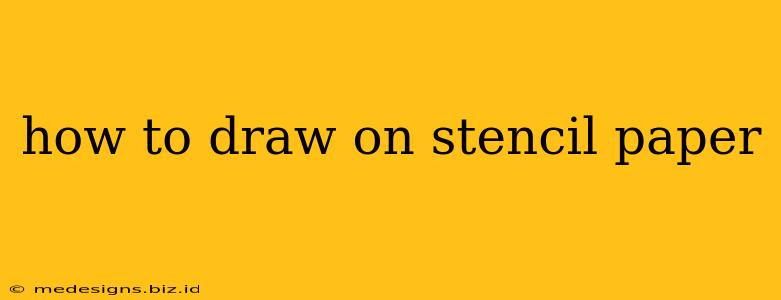Creating stunning designs with stencils is easier than you think! This comprehensive guide will walk you through everything you need to know about drawing on stencil paper, from choosing the right materials to mastering different drawing techniques. Whether you're a seasoned artist or just starting out, this guide will help you achieve professional-looking results.
Choosing Your Stencil Paper and Tools
The first step in any successful stencil project is selecting the appropriate materials. The type of stencil paper you choose will greatly impact the final product.
Types of Stencil Paper:
-
Mylar Stencil Film: Known for its durability and reusability, Mylar is ideal for multiple uses. It's resistant to tearing and holds up well to repeated cleaning. Perfect for intricate designs and multiple applications.
-
Card Stock: A more affordable option, card stock is readily available and easy to work with. It's suitable for one-time use stencils or projects that don't require extreme durability. Great for beginners and simple designs.
-
Clear Plastic Sheets: These offer a good balance between cost and durability. They allow you to see your design through the stencil, making it easier to position accurately.
Essential Drawing Tools:
-
Fine-tip permanent markers: These are crucial for creating clean, crisp lines that won't bleed through the stencil material. Choose markers with a fine nib for intricate details. Avoid using pens or pencils that might smudge or bleed.
-
Sharp craft knife or X-ACTO knife: Necessary for cutting out the stencil design once you've finished drawing it. A sharp blade ensures clean cuts and prevents tearing. Always use a cutting mat to protect your work surface.
-
Ruler: Useful for creating straight lines and achieving precise measurements in your design.
Drawing Your Stencil Design: Step-by-Step
Now that you have your materials, let's get to the drawing!
1. Plan Your Design:
Before you start drawing, sketch your design on a separate piece of paper. This allows you to refine your idea and make any necessary adjustments before transferring it to the stencil paper. Keep the design relatively simple, especially if you're a beginner.
2. Transferring Your Design:
You can transfer your design in a few ways:
-
Tracing: Place your sketch underneath your stencil paper and carefully trace the outline with a fine-tip pen or marker. Use a lightbox or a window to make tracing easier.
-
Freehand Drawing: If you're comfortable, you can draw directly onto the stencil paper using a fine-tip marker. This requires a steady hand and precision.
3. Cutting Out Your Stencil:
Once your design is drawn, carefully cut out the negative spaces of your stencil using a sharp craft knife or X-ACTO knife. Work slowly and methodically to avoid mistakes. Use a ruler to guide your cuts for straight lines.
4. Test Your Stencil:
Before using your stencil on your final project, test it on a scrap piece of material. This helps ensure that everything is cut correctly and allows you to adjust your technique if needed.
Tips for Success:
-
Use a light touch: When drawing on stencil paper, use a light touch to avoid excessive pressure which might damage the paper or cause bleeding.
-
Clean your stencil: After each use, clean your stencil with a damp cloth or mild detergent to remove any paint or debris. This will ensure that your stencil remains usable for future projects.
-
Practice makes perfect: Don't be discouraged if your first few attempts aren't perfect. The more you practice, the better you'll become at creating intricate and professional-looking stencils.
Different Stencil Techniques:
Explore beyond simple shapes! Experiment with layering stencils for complex designs, or create reverse stencils for unique effects. This opens a world of creative possibilities.
By following these steps and tips, you'll be well on your way to creating beautiful and professional-looking stencils. Happy crafting!
